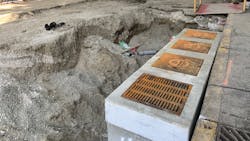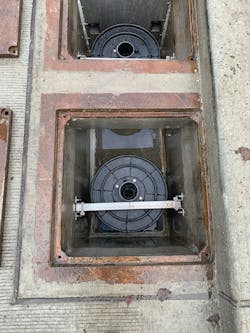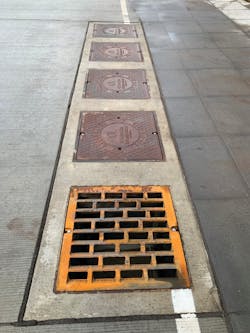New stormwater system refreshes Seattle waterfront
The newly updated Seattle Waterfront is a magical place, offering visitors and residents alike a place to walk, eat, hang out or take part in a plethora of outdoor activities like shopping, sightseeing, admiring the sea otters and waving to the harbor seals, whale-watching cruises, or even taking a ride on the Seattle Giant Wheel. Opportunities abound to soak up some of the legendary PNW atmosphere as you stand and take in the beautiful Puget Sound and the Olympic Mountains. Bike lanes and pedestrian improvements provide easy pathways to navigate the entire development.
The primary goal of the Seattle Waterfront project is to connect the downtown and historic piers into one single cohesive system, providing an easily walkable experience accessible to all. The project has completely reimagined the flow of the city, both from a tourist sightseeing angle, and through the infrastructure lens.
Before the customer-facing side of the Seattle Waterfront project could move into development and existence, new protective infrastructure issues needed to be addressed. This included building a seismically stable seawall and installing a green stormwater management system to maintain runoff throughout the entire development.
Each of the new stormwater management systems installed were charged with meeting regulatory requirements for basic stormwater treatment according to General Use Level Designation (GULD) approval by the State of Washington Department of Ecology and the City of Seattle (both Seattle Public Utilities and the Seattle Department of Transportation). The GULD parameters ensured that only technologies whose evaluation reports demonstrated confidently and fully the ability to achieve the performance goals set forth by the Department of Ecology would be used.
One of the largest tasks facing the infrastructure piece of the Seattle Waterfront project is the coordination of multiple stakeholders. From government agencies to contractors to chosen vendors, details mattered. Even more important was ensuring all details were accurate throughout the process.
Navigating the complex infrastructure below street level, while minimizing the disturbance to tourists, residents, and business owners, was daunting as each partner in the process worked together to effectively tie in new construction for multiple utilities.
One key piece of the infrastructure construction process was the existing Alaskan Way viaduct, fully demolished in 2019, which would be replaced by a new Alaskan Way within the exact same footprint. Numerous moving parts and details resulted in a vastly complex installation schedule, while extraneous forces demanded precision in execution throughout every phase of the project.
The challenges within the project continued: the necessity of meeting the HS-25 traffic load rating for all structures involved (a classification used to rate the strength of a system to determine where it can be used and how much of a load it will be able to handle; according to the American Association of State Highway and Transportation Officials (AASHTO) (HS-25 is an interpretation of AASHTO’s HL93 truckload and is defined as being 20% higher than the HS-20 design truckload) as well as redesigning pedestrian and vehicular traffic to install media filtration systems proven to remove and retain the toughest pollutants from stormwater runoff coming from developed urban and suburban sites.
And finally, it was necessary to ensure that the approved inlet vane grating was on all CB units, and stamped architectural design calculations and drawings for each unit on the project were provided.
The solution: precast concrete media filtration
When choosing a stormwater solution, be sure to do the necessary research to select a media filtration option that identifies the correct system sizing that fits the site-specific stormwater filtration requirements. If the correct tool is chosen, it will use site-specific inputs to walk you through the selection process and provide product details upon completion.
Why? Impervious surfaces and other urban and suburban landscapes generate a variety of contaminants that can enter stormwater, polluting downstream receiving waters. A good cartridge-based media filtration system with a proprietary media configuration will remove specific pollutants of concern through sedimentation, filtration, and sorption, reducing downstream contaminants.
A few features/benefits to look for in a media filtration stormwater management solution:
- Captures and retains target pollutants, reducing the total downstream discharge load;
- Flexible configurations available in multiple sizes, to include vaults, manholes, and catch basins;
- Variable inlet/outlet locations;
- High-efficiency treatment in a compact footprint;
- Field & lab tested for the removal of Total Suspended Solids (TSS) and phosphorus;
- An integrated bypass system that reduces construction costs by eliminating the need for a separate bypass structure;
- A pre-treatment chamber designed to prolong the media lifespan by removing pollutants;
- A simple modular cartridge construction that provides for the efficient replacement and cartridge handling; and
- Ensure that the stormwater solution you choose meets or exceeds all necessary regulatory requirements and approvals.
The stormwater solution chosen for the Seattle Waterfront project was a precast concrete vault cartridge media filtration system that stood out among the competition for multiple reasons. With both catch basins and vault units used in the design of the complicated project, the City of Seattle sought the longevity of a solution that can only be found in a precast concrete option. The chosen product had been used by Seattle before with great success, resulting in a level of familiarity and trust with the product that helped ensure the project’s (and the product’s) success. All systems selected were sized according to the City of Seattle Stormwater Design Manual to include multiple drainage areas and corresponding treatment flow rates.
The resultsSelecting a precast concrete media filtration system for the Seattle Waterfront project brings with it multiple results which are now being realized by the city and will continue to work to best serve and protect the project.
Longevity. Due to the selection of a precast concrete option, the media filtration stormwater solution product chosen offers more reliability than steel when used in a marine climate. This is not new news: concrete has long been the infrastructure and building product of choice for seawalls, breakwaters, bulkheads, and other sea water-exposed infrastructure projects. The long-term durability and service life of concrete is unmatched and provides a more confident solution for the overall sustainability of the infrastructure.
Security. Compared to other products, a strong precast concrete cartridge filtration stormwater solution stands up to vehicular traffic better if a strong top lid design is incorporated. The product selected featured a lid that fastens securely to remain resistant and clatter-free when subjected to standard vehicular traffic.
With the stormwater management portion of the Seattle Waterfront project now complete, the City of Seattle rests assured that the selection of a precast concrete media filtration system will serve the project and the city well into the future.
About the Author
Kathryn Thomason
Water Resource Engineer
Kathryn Thomason is a water resource engineer for Oldcastle Infrastructure.




